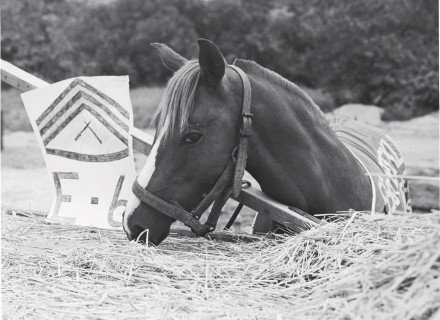Stretching back to Texas’ own fight for independence from Mexico, tales have been told about the heroics of Texans during battle.
Here, we recognize just a minuscule sampling of the soldiers — from the Texas Revolution to World War I and World War II, Vietnam and the military conflicts of today — who fought valiantly in the face of danger.
 October 12, 1835
October 12, 1835
Siege of Béxar, San Antonio
Stephen F. Austin, “The Father of Texas,” leads the Texas army in a successful siege of the Mexican-occupied town of Béxar in one of the earliest encounters of the Texas Revolution.
Stephen F. Austin. Photography: Courtesy Texas State Library and Archives Commission
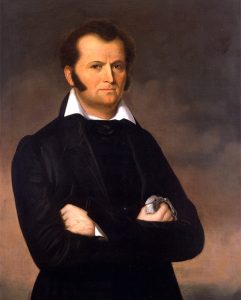 October 28, 1835
October 28, 1835
Battle of Concepción, San Antonio
James Bowie and his Texas army successfully defend the Mission Concepción in San Antonio in the first major battle of the Texas Revolution.
Oil painting of James Bowie by George Peter Alexander Healy. Photography: Courtesy Texas State Preservation Board
February 24, 1836 | The Siege of the Alamo, San Antonio

William B. Travis, the commander of Texas forces under siege at the Alamo, calls for reinforcements in the famous letter in which he declares he will fight until the end, “like a soldier who never forgets what is due to his own honor and that of his country — Victory or Death.”
Travis by Ruth Conerly. Photography: Courtesy Texas General Land Office
March 6, 1836 | Battle of the Alamo, San Antonio
Davy Crockett, who chirped, “You may all go to hell and I will go to Texas,” dies alongside James Bowie, William B.Travis, and every single Texas army soldier — none of whom were originally from Texas — present at the Battle of the Alamo.

The Alamo Cenotaph in San Antonio. Photography: Courtesy Alamo Trust, Inc.
 April 21, 1836
April 21, 1836
Battle of San Jacinto, Houston
Sam Houston, who would become the first president of the Republic of Texas, defeats the Mexican army in the final battle of the Texas Revolution, where the rallying cry “Remember the Alamo!” is born.
A Tribute to Courage, the 67-foot-tall statue of Sam Houston by sculptor David Adickes, in Huntsville, Texas, just outside Houston. Photography: Dreanna L. Belden/Courtesy University of North Texas Libraries, The Portal to Texas History
 July 18, 1918 | Soissons, France
July 18, 1918 | Soissons, France
George Lawson Keene storms a German stronghold and captures an officer carrying a map of enemy positions. For this, Keene would receive the Distinguished Service Cross. As one of the most decorated American soldiers of World War I, Keene also received two Silver Stars, multiple Purple Hearts, and numerous service medals from France and Italy.
George Lawson Keene. Photography: Courtesy The Houston County Historical Commission
December 7, 1941 | Pearl Harbor, Hawaii
Doris “Dorie” Miller, a crewman aboard the USS West Virginia, mans the anti-aircraft machine guns and carries injured sailors to safety during the attack on Pearl Harbor. For his actions, Miller becomes the first African American awarded the Navy Cross.
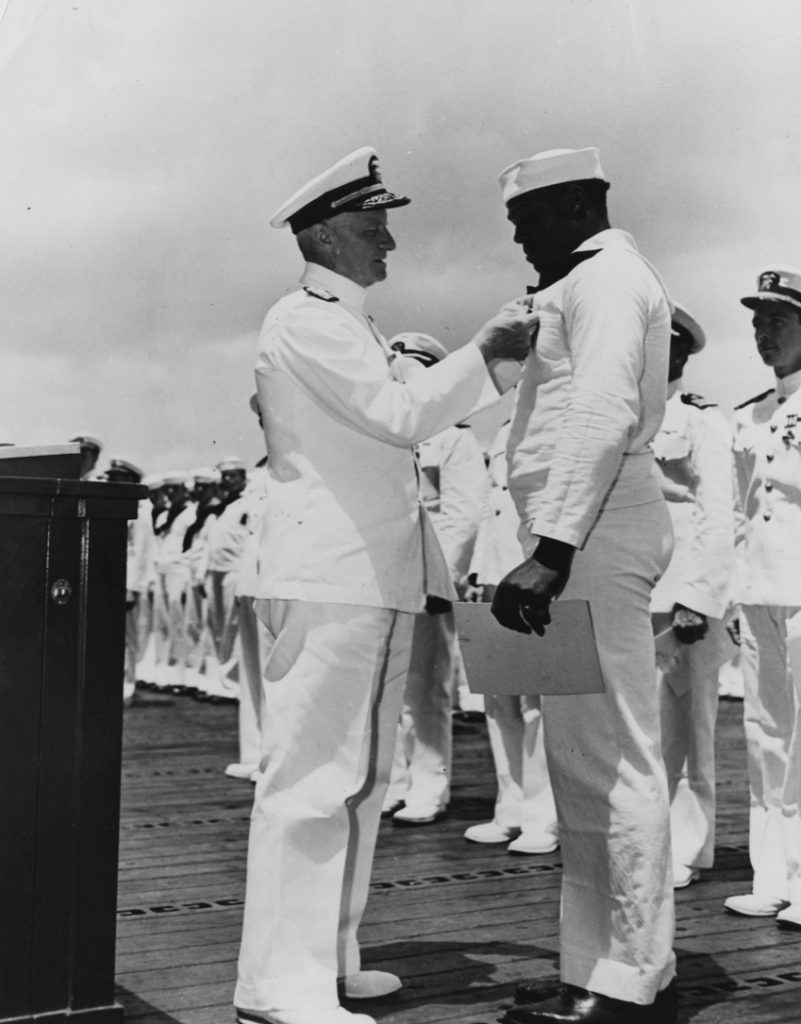
Fleet Admiral Nimitz awards Doris Miller the Navy Cross on board USS Enterprise, Pearl Harbor, 1942. Photography: Courtesy U.S. Navy/Nimitz Foundation
June 6, 1944 | Normandy, France
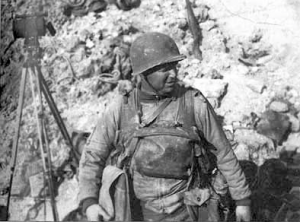
James Earl Rudder, commander of the U.S. Army 2nd Ranger Battalion, scales the 100-foot cliffs of Pointe du Hoc with his men while under enemy fire to destroy the German gun batteries and establish a beachhead for the allied forces during D-Day. Rudder, eventually a major general who also served during the Battle of the Bulge, received the Distinguished Service Cross, two Bronze Stars, two Purple Hearts, and numerous other honors.
Rudder at Pointe du Hoc, June 7, 1944. Photography: Courtesy of Texas A&M University Press
November 27, 1944 | Grosshau, Germany
Marcario García frees his company from enemy fire by destroying two German encampments on his own with just a rifle and some grenades, despite being injured. His heroics would earn García the Medal of Honor, making him the first Mexican immigrant (his family moved to Sugar Land, Texas, when he was about three years old) to receive the award.

President Truman bestows the Medal of Honor on Marcario García. Photography: Courtesy the National Archives and Records Administration
January 26, 1945 | Holtzwihr, France
Audie Murphy, at the age of 20, single-handedly fends off a company of German soldiers for an hour before rejoining his men and mounting a successful counter-attack, despite being wounded. For these actions, Murphy received the Medal of Honor, and he would go on to receive every single military award for valor available from the army.

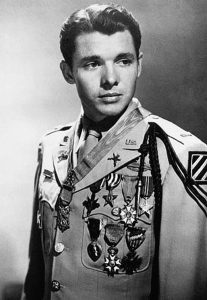

The May 10, 1949, issue of Look Magazine (Photography: Courtesy Audie Murphy Research Foundation). Audie Murphy photographed in 1948 wearing the U.S. Army khaki "Class A" (tropical service) uniform with full-size medals (Photography: Courtesy U.S. Army). Murphy starred in the big screen adaptation of his life story in the film To Hell and Back.
February 23, 1945 | Iwo Jima, Japan
Harlon Block and five other marines raise the American flag on Mount Suribachi during the Battle of Iwo Jima — a moment immortalized in one of the most iconic and recognizable photographs of the war: Raising the Flag on Iwo Jima by Joe Rosenthal. Block is the marine at the base of the flag, closest to where it is being planted in the ground. He died during combat just days before the battle ended on March 26, 1945.

The U.S. Marine Corp War Memorial, based on Raising the Flag on Iwo Jima, by sculptor Felix de Weldon in Arlington, Virginia. Harlon Block is the marine at the base of the flag, closest to where it is being planted in the ground. Photography: Catie Drew/Courtesy Federal Highway Administration
September 2, 1945 | Tokyo Bay, Japan
Chester W. Nimitz, Fleet Admiral of the U.S. Navy and Commander in Chief of the Pacific Fleet — commanding all allied land and sea forces during World War II — signs the Japanese Instrument of Surrender aboard the USS Missouri on behalf of the United States.

Fleet Admiral Nimitz signs the surrender document on board USS Missouri, Tokyo Bay, Sept. 2, 1945. Photography: Courtesy U.S. Navy/Nimitz Foundation
May 2, 1968 | Loc Ninh, Vietnam
 Roy Benavidez saves the lives of at least eight men while under attack on a rescue mission. Benavidez carried wounded soldiers to helicopters, protected classified documents, and survived the six-hour battle despite multiple gunshot wounds, copious fragmentation holes, bayonet slashes on both arms, a destroyed lung, and numerous other injuries. He received the Distinguished Service Cross and the Medal of Honor for his heroics.
Roy Benavidez saves the lives of at least eight men while under attack on a rescue mission. Benavidez carried wounded soldiers to helicopters, protected classified documents, and survived the six-hour battle despite multiple gunshot wounds, copious fragmentation holes, bayonet slashes on both arms, a destroyed lung, and numerous other injuries. He received the Distinguished Service Cross and the Medal of Honor for his heroics.
Roy Benavidez with Defense Secretary Caspar Weinberger and President Ronald Reagan at his Medal of Honor ceremony in 1981. Photography: Courtesy Ron Hall/U.S. Air Force
March 2003 | Nasiriya, Iraq
Chris Kyle, the most lethal American sniper in history, records his first of 160 confirmed kills while protecting a Marine convoy during his first deployment to Iraq. Kyle, a Navy SEAL, would serve four tours of duty in Iraq and receive a Silver Star and multiple Bronze Stars for his service.
Crowds gathered the pay their respects along Chris Kyle’s funeral procession route in 2013, which spanned 200 miles, from Kyle’s home in Midlothian, Texas, to his burial place at the Texas State Cemetery in Austin, with a memorial service at the Dallas Cowboys’ AT&T Stadium in Dallas. Video: Courtesy Cowboy Dave
June 27, 2005 | Kunar Province, Afghanistan
Marcus Luttrell survives the ambush of Operation Red Wings after suffering multiple wounds and the loss of his fellow Navy SEALs during the attack. Luttrell received the Navy Cross for his actions during the operation.

Matthew G. Axelson, Daniel R. Healy, James Suh, Marcus Luttrell, Shane Patton, and Michael P. Murphy. With the exception of Luttrell, all were killed by enemy forces while supporting Operation Red Wings. Photography: Courtesy U.S. Navy
May 1, 2011 | Abbottabad, Pakistan
William H. McRaven, Vice Admiral of the Navy and Commander of Joint Special Operations Command, directs and oversees SEAL Team 6 in Operation Neptune Spear, resulting in the death of Osama bin Laden.

William McRaven speaks with emergency room staff members at the Heathe N. Craig Joint Theater Hospital during a Thanksgiving Day visit at Bagram Airfield, Parwan province, Afghanistan, 2013. Photography: Rob Hazelett/Courtesy U.S. Navy
An abridged version of this article appears in the July 2019 issue.
















